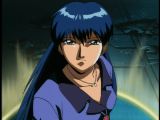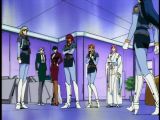

Quick Links:
Silent Möbius, TV Series
If I was ever to hand out awards for the best anime that nobody has ever seen, Silent Möbius would be one of the first winners. Yes, it was shown on TechTV as part of their Anime Unleashed line, but did you actually watch it? Yeah, I didn’t think so. Based on one of Kia Asamiya’s early manga works, the story of Silent Möbius is set in the near future, one that has many similarities to the world of today. The story takes place in 2028-29, and the typical sci-fi trappings of cyborgs and flying cars and the like are in place, but for the most part people still drive normal cars and have normal jobs and life seems to go on at the regular pace of a modern society.
Under the surface, however, things are much different than they appear. An alien race, called the Lucifer Hawks, is living in the city, preying on the defenseless citizens. But while regular people can’t hope to oppose the aliens (and the government is trying to hide the fact that they even exist), a special branch of the police force can fight them. This branch, called the Attacked Mystification Police, or AMP, has the special skills and talents to allow them to fight the aliens. Interestingly enough, the members of AMP are all women, and a rather diverse lot, at that. One of them is half-cyborg, one is a Shinto priestess, one is a super computer expert, and one of them has psychic, precognitive powers.
Into this mix is thrown Katsumi Liqueur, the heroine. She is the daughter of a famous magician, and has inherited his incredible powers. Even though she is unaware of these powers, others in the world are aware of them, including Rally Cheyenne, the leader of AMP, who aims to recruit Katsumi into her special police force. The Lucifer Hawks, however, are also aware of Katsumi, and her link to her father’s powers makes her very useful to them, as well. Because of this, repeated attempts are made by the aliens to recruit Katsumi to their side. Toss in a romantic interest to add to the drama and you’ve got yourself a show with bona fide appeal to both science fiction and fantasy fans, with a small touch of romance on the side.
The best thing about Silent Möbius is the story. I am not very familiar with the original manga (I’ve only read a few chapters about halfway through the entire saga), so I can’t compare the two. From what I understand the overall concept seems the same. The story in the television show mostly revolves around Katsumi and the actions she takes to face her heritage and her destiny. She makes a fairly sympathetic character, and I can easily understand her initial reactions to all of the early revelations in the series about her past, her parents, and what it all means for her and for all of humanity. And for those of you who like plot twists, there is one involving Katsumi about 3/4 of the way through the series that really blew me away. Suffice it to say that even though you think you know what is going on, you really don’t.
While the main plot of the fight of the AMP against the Lucifer Hawks takes up more episodes than anything else, that isn’t the only thing this show covers. Around a third of the episodes in this 26-episode series relate to the other members of AMP. While in some TV shows, the episodes that don’t directly relate to the main story arc feel like useless filler, that isn’t the case in Silent Möbius. This isn’t to say that every side story is brilliant, but almost all of them are actually tied in one way or another into the main story, though in ways that only become evident in the last few episodes as all (well, OK, many of) the plot threads tie together.
For example, one of the side stories involving Yuki Saito has her traveling back in time and falling in love with a man from 1998-era Tokyo. Near the end of the series, you learn that this same man has actually been around the whole time, being involved in some stuff behind the scenes. On the flip side, there’s Nami, whose side story seems to have little point outside of some minor character development. For the most part, though, the side stories actually relate to the overall story, even though not all of them get properly tied out in the final reckoning. Actually, the main story line doesn’t get completely resolved. The issues surrounding Katsumi get resolved (because the show is really about her, not the AMP), but the fight with the Lucifer Hawks doesn’t. This is a minor annoyance, but the way that it is written works well enough that I am satisfied.
It’s a good thing that the show has a well-written and well-paced story, because the actual animation is spotty at best. Sometimes, the show is a real visual treat, with excellent use of color palettes and lighting, and nice, sharp lines. Sometimes, however, you get the impression that the animators simply ran out of time and had to rush some episodes, as the animation quality in some episodes, which isn’t always great to begin with, really drops as the episode progresses. This isn’t a problem in the first episode, which I’m sure was animated by the main studio involved in the show, Radix. By the second episode, though, you’ll start to come across some scenes which were obviously done on about a $5 budget. This can get a little jarring, as you move from rich, deep colors, to washed out colors, to rich, deep colors again, all in about 10 seconds. It also looks like a number of different animation studios were involved in the show, as the characters simply look different from episode to episode. This is more evident in the less-relevant side stories, but even in the more important episodes the characters, mechanical designs, and the backgrounds will look noticeably different. And by different, I mean “lower quality.” Ah, the joys of strict deadlines and budget pressures.
On the plus side, Silent Möbius has some excellent music. The background music was composed by Kenichi Sudo, Takashi Furukawa, Suzie Katayama, and, somewhat surprisingly, Jimmie Haskell, a prodigious American composer who has won Emmy and Grammy awards, and has composed and arranged music for tons of movies, plays, and television shows. With this kind of talent involved, it comes as no surprise that the music in Silent Möbius is almost uniformly excellent. Some of the background music is your standard “do it all on a synthesizer” fare, some is fully orchestrated (occasionally with choir), and some is in the a pop or rock band style. Whatever the style, the music all shows a high level of quality, and almost never did I dislike a piece of music or feel that it didn’t belong in the scene in which it was used. Interestingly enough, all of the vocal music, with the exception of the opening title song, is done entirely in English, most of it done by what sounds to be native English speakers. This is an interesting stylistic choice. Even though most of the story is set in Tokyo, the use of English singing gives the show somewhat of a cosmopolitan feel. It obviously works very well when listening to the English vocal track.
Speaking of the vocal tracks, either works fine, depending on your preference. Both tracks are in a standard stereo mix, and I didn’t notice any audio problems on either one. Sometimes the English voice actors sound stilted in certain scenes. From what I can tell, this stems from the fact that they are trying to match their speaking to the animated lip movements. Sometimes this works fine, but sometimes it gets annoying. The voice actor for the character Robert Device is the worst at this; sometimes he sounds like he is trying to impersonate William Shatner. In case you are wondering, that’s not a good thing. Still, that being taken into account, the English track still stands up on its own merits.
In the end, Silent Möbius is a fun show that surprised me in many ways. None of the characters are idealized, as they all have strengths and weaknesses that play into the overall story. And outside of some slipshod animation at times, the show has a good level of quality that shows that the producers actually cared about the show, and didn’t just need something to fill a timeslot. The DVDs are available in dual-packs that contain two DVDs each, while only costing one and a half times the list price of a regular DVD, so the show is a little bit of a bargain, especially if you can find it discounted somewhere. If you like your science fiction with some fantasy tossed in, you will find Silent Möbius to be right up your alley.
Distributor: Viz Creator: Studio Tron (Kia Asamiya) / Radix / TV Tokyo Released: 1998
Video Quality: B Audio Quality: A- Presentation: B+ Content: A- Overall: B+



